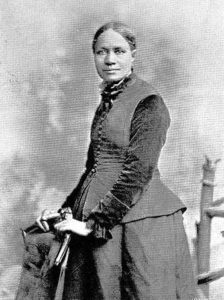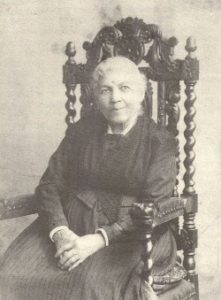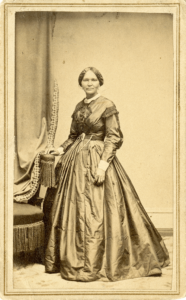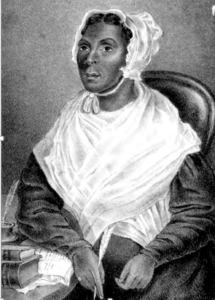Combating Racism – 19th Century Black Female Authors – Part 2
Last week I visited the National Portrait Gallery and saw, among others, the current exhibit entitled “Her Story: A Century of Women Writers” which highlights 24 noted women writers from the last 100 years who are represented in the Portrait Gallery’s collection. Among them were four Black women writers: Maya Angelou, Lorraine Hansberry, Toni Morrison, and Alice Walker. Seeing these famous authors made me even more committed to share the names and biographies of these little remembered women authors of the 19th century.
FRANCES WATKINS HARPER (1825 – 1911)

Frances Watkins Harper was born to free Black parents. By the time she was three years old, both of her parents had died and she became an orphan. Her aunt and uncle raised her after her parents’ deaths. Her uncle, William Watkins, was an outspoken abolitionist who organized a Black literary society and established his own school in 1820 called the Watkins Academy for Negro Youth. Frances attended the Academy until she was 13 years old, when she took a job as a nursemaid and seamstress for a White family that owned a bookstore. Her love for books blossomed as she spent any free time she had in the bookshop.
By age 21, Harper wrote her first small volume of poetry called Forest Leaves. When she was 26 years old, she became the first woman instructor at Union Seminary, a school for free Blacks in Wilberforce, Ohio. She taught domestic science for a year and then moved to a school in York, Pennsylvania. There she moved in with William and Letitia Still, abolitionists and friends of her uncle. William Still became known as the father of the Underground Railroad. Supported by the Stills, Harper began writing poetry for antislavery newspapers. Her poem, “Eliza Harris,” was published in The Liberator and in Frederick Douglass’ newspaper. By the time she left Philadelphia in 1854, she had compiled her second small volume of poetry called Poems on Miscellaneous Subjects with an introduction by abolitionist William Lloyd Garrison. This second collection sold more than 10,000 copies—a record for a poetry collection by a writer.
For the next eight years, Harper traveled across the United States and Canada as a lecturer. After her first speech entitled, “The Elevation and Education of our People,” she was hired as a traveling lecturer for various organizations including the Maine Anti-Slavery Society and the Pennsylvania Anti-Slavery Society. In addition to her antislavery lectures, Harper was committed to the struggle for women’s rights and the temperance movement. She included her observations from her travels in her writings and began to publish novels, short stories, and poetry focused on issues of racism, feminism and classism. In 1859, Harper published a short story in the Anglo-African Magazine called “The Two Offers.” This short story about women’s education was the first short story published by a Black American woman.
In 1866, Harper spoke at the National Woman’s Rights Convention in New York. Her famous speech entitled, “We Are All Bound Up Together,” urged her fellow attendees to include Black women in their fight for suffrage. She emphasized that Black women were facing the double burden of racism and sexism at the same time, therefore the fight for women’s suffrage must include suffrage for Black Americans. That same year, Harper helped to establish the National Association of Colored Women.
Harper achieved international acclaim as an author and speaker. Through her poetry, fiction and nonfiction writing, she inspired Americans to create change in society. She spent her career working for the pursuit of equal rights, and job opportunities and education for Black women. She was a co-founder and vice president of the National Association of Colored Women’s Clubs and the director of the American Association of Colored Youth. She was also the superintendent of the Colored Sections of the Philadelphia and Pennsylvania Women’s Christian Temperance Unions. One of her most famous quotes, “…no nation can gain its full measure of enlightenment…if one-half of it is free and the other half is fettered” encapsulates her philosophy as an educator, writer, and social and political activist.
PAULINE ELIZABETH HOPKINS (1859 – 1930)

Pauline Hopkins was born in Portland, Maine to free parents of color who raised her in Maine for a short time before moving to Boston. Her father was a Civil War veteran and member of the Grand Army of the Republic (GAR), a fraternal organization of veterans of the Civil War. Her high-achieving family encourage her academically, which led her to develop an appreciation for literature.
In Boston, Hopkins attended Girls High School, a leading secondary institution in the region. While there, Hopkins, then 15, entered an essay competition for Black students that was hosted by former slave William Wells Brown, considered at the time to be the nation’s premier Black novelist. Hopkins placed first in the competition and received the $10 prize for her essay, “Evils of Intemperance and Their Remedies.”
At the age of 16, Hopkins began her career as a stage performer, debuting with a Boston choral group. Two years later, in 1877, she was chosen to be the lead actress in the stage production of Pauline Western, the Belle of Saratoga. Her first original play, Slaves’ Escape or The Underground Railroad, opened in Boston in 1880. Hopkins was only 21 at the time.
In 1895, she took a position as a stenographer in the Bureau of Statistics for the Massachusetts Decennial Census. However, writing remained her passion and in 1900 her short story, “Talma Gordon,” was published, becoming the first Black American mystery story. She explored the difficulties faced by Blacks amid the racist violence of post-Civil War America in her first novel, Contending Forces: A Romance Illustrative of Negro Life North and South, also published in 1900. Hopkins authored her first short piece of published fiction, “The Mystery Within Us,” which appeared in Colored American Magazine.
By 1902, Hopkins had become the editor of Colored American and during this period, she also authored three novels: Hagar’s Daughter: A Story of Southern Caste Prejudice (1901); Winona: A Tale of Negro Life in the South and Southwest (1902); and Of One Blood, or, the Hidden Self (1903). In 1915, Hopkins became the first Black editor of New Era Magazine, one of the leading journals of the period. The New Era folded in 1918, and Hopkins ended her brief but brilliant literary career. That year she became a stenographer at the Massachusetts Institute of Technology, a position she held for the rest of her life.
Pauline Hopkins is considered a pioneer in her use of the romantic novel to explore social and racial themes.
HARRIET A. JACOBS (1813 – 1897)

Harriet Jacobs was born into slavery in Edenton, North Carolina. When Jacobs was six years old, her mother died. She then lived with her mother’s owner, Margaret Horniblow, who taught her not only to sew, but also to read and write. Very few slaves were literate, although it was only in 1830 that North Carolina explicitly outlawed teaching slaves to read or write.
After Margaret Horniblow died in 1825, Harriet was bequeathed to the woman’s three-year-old niece, Mary Matilda, the daughter of Dr. James Norcom. Over the years, Dr. Norcom’s unwanted sexual advances and his wife’s vindictive jealousy tormented Harriet. When Norcom threatened to sell her children if she did not submit to his desire, she hid in a tiny crawl space under the roof of her grandmother’s house. The small garret was about nine feet long, seven feet wide and just three feet high at the highest point.
After staying there for seven years, Harriet finally managed to escape to the free North, where she was reunited with her children Joseph and Louisa Matilda and her brother John S. Jacobs. She found work as a nanny and got into contact with abolitionist and feminist reformers. Even in New York, her freedom was in danger until her employer, an anti-slavery sympathizer, arranged for her purchase and freed her.
In June 1853, Jacobs read a defense of slavery entitled “The Women of England vs. the Women of America” in an old newspaper. Written by Julia Tyler, wife of former president John Tyler, the text claimed that the household slaves were “well clothed and happy”. Jacobs spent the whole night writing a reply, which she sent to the New York Tribune. Her letter, signed “A Fugitive Slave”, published on June 21, was her first text to be printed. Her biographer, Jean Fagan Yellin, wrote, “When the letter was printed …, an author was born.”
In late 1852 or early 1853, Amy Post, abolitionist and women’s rights activist, suggested that Jacobs write her life story. Jacobs felt a moral obligation to tell her story to help build public support for the antislavery cause and thus save others from suffering a similar fate. Her autobiography, Incidents in the Life of a Slave Girl, published in 1861 under the pseudonym Linda Brent, is now considered an American classic. The constant danger for herself and other slave mothers of being separated from their children is an important theme in the autobiography.
The book was well received by critics. Rather than the contempt Jacobs had feared, she gained respect. Although she had used a pseudonym, in abolitionist circles she was regularly introduced with words like “Mrs. Jacobs, the author of Linda”, thereby conceding her the honorific “Mrs.” which normally was reserved for married women. The London Daily News wrote in 1862, that Linda Brent was a true “heroine”, giving an example “of endurance and persistency in the struggle for liberty” and “moral rectitude.”
In the spring of 1862, Harriet Jacobs went to Washington, D.C. and Alexandria, Virginia. She summarized her experiences in a report entitled Life among the Contrabands, published that September in William Lloyd Garrison’s The Liberator. Her report describes fugitives’ misery and denounces slavery. Jacobs emphasized her conviction that freedmen would be able to build self-determined lives, if they got the necessary support.
After Union troops occupied Alexandria in 1861, some schools for Blacks emerged, but there was not a single free school under Black control. Jacobs supported a project conceived by the Black community in 1863 to found a new school. In the fall of 1863 her daughter Louisa Matilda who had been trained as a teacher, came to Alexandria. After some struggle with White missionaries from the North who wanted to take control of the school, the Jacobs School opened in January 1864 under Louisa Matilda’s leadership. In the National Anti-Slavery Standard, Harriet Jacobs explained that it was not disapproval of White teachers that made her fight for the school being controlled by the Black community. But she wanted to help the former slaves, who had been raised “to look upon the White race as their natural superiors and masters,” to develop “respect for their race.”
In the spring of 1864 she was elected to the executive committee of the Women’s Loyal National League, an organization founded in 1863 which aimed at collecting signatures for a constitutional amendment to abolish slavery. On August 1, 1864 she delivered a speech on the occasion of the celebration of the British West Indian Emancipation in front of the Black soldiers of a military hospital in Alexandria, Virginia.
In her later years, she and her daughter kept a boarding house, first in Cambridge, Massachusetts and later in Washington, D.C., until in 1888, she became too sick to continue with the boarding house. Harriet Jacobs died on March 7, 1897 in Washington, D.C.
ELIZABETH HOBBS KECKLEY (1818 – 1907)

Elizabeth Hobbs was born into slavery in 1818 on the Col. Armistead Burwell farm in Dinwiddie County, Virginia. Her biographer, Jennifer Fleischner, asserts that Col. Burwell was Hobbs’s father.
When Hobbs was fourteen, she was sent to live with her master’s eldest son, the Reverend Robert Burwell, and his wife in North Carolina. During this time she endured whippings and beatings from the village schoolmaster, a Mr. Bingham, ostensibly to subdue her “stubborn pride,” as she later wrote. At age twenty, she became pregnant as the result of a rape, and her only child, George, was born in 1839. After the birth of her son, 21-year-old Hobbs was sent back to Virginia to live with her master’s daughter, Ann Burwell Garland, and Ann’s husband. She accompanied the Garland family when it moved west to St. Louis in 1847. There she began work as a seamstress and dressmaker, skills she had learned from her mother. Her work helped support the entire Garland family.
Hobbs’s reputation as a skilled dressmaker grew quickly and her patrons soon included some of St. Louis’s most elite citizens. While in St. Louis, Hobbs consented to marry James Keckley on the condition that Hugh Garland allowed her to purchase her freedom. Although not yet free, she married James Keckley in 1852 but only after Garland agreed to a purchase price of $1200.
On August 10, 1855, with money borrowed from some of her wealthy patrons, Elizabeth Keckley secured her freedom and that of her son. The marriage union, however, proved unhappy. James Keckley had misrepresented himself as free, and in 1860, Elizabeth left her husband and settled in Washington, D.C. All of the money she borrowed was repaid in full by that point.
In Washington, D.C., Keckley built a successful dressmaking career becoming acquainted with Mary Lincoln, whom Keckley met on President Lincoln’s first day in office. Her work for and friendship with Mary Lincoln permitted her a unique view of events during this era which she chronicled in her book, Behind the Scenes By Elizabeth Keckley, Formerly a Slave, But More Recently Modiste, and Friend to Mrs. Abraham Lincoln, Or, Thirty Years a Slave, and Four Years in the White House (1868).
Keckley also became a prominent figure in D.C.’s free Black community, helping to found and serving as president of the Contraband Relief Association, which later became the Ladies’ Freedmen and Soldier’s Relief Association. After Lincoln’s assassination, Keckley stayed with the first lady for a time, but the publication of her book, in which she revealed private details about life inside the White House, was controversial and strained her relationship with Mary Lincoln. The negative reaction to the book in D.C.’s White community affected Keckley’s ability to earn a living. Finally in 1892 at age 74, she took a faculty position at Wilberforce University in Ohio as head of the Department of Sewing and Domestic Science Arts.
Elizabeth Hobbs Keckley died in May of 1907 while living at the National Home for Destitute Colored Women and Children in Washington, D.C. She is best known as Mary Lincoln’s dressmaker. The purple velvet gown, designed and made by Keckley and worn by Mary Lincoln at her husband’s second inauguration, can be viewed at the Smithsonian’s American History Museum.
JARENA LEE (1783 – 1864)

Jarena Lee, whose family or maiden name is unknown, was born to a poor but free Black family on February 11, 1783, in Cape May, New Jersey. In 1790 at the age of seven, Lee was sent to work as a live-in servant for a White family named Sharp.
Lee moved to Philadelphia, Pennsylvania as a teenager and continued to work as a domestic servant. One afternoon, Lee attended a worship service at Bethel Church where Bishop Richard Allen, founder of the African Methodist Episcopal (AME) Church, was preaching. After hearing Allen’s powerful sermon, Lee converted to Christianity.
In 1807 Lee heard the voice of God commissioning her to preach the Gospel. She was initially reluctant to pursue ministry, given the male-dominated nature of the church. However, she confided in Bishop Allen and revealed to him her call to preach. Allen told her that he could not grant her permission to preach because the AME Church banned female ministers.
In 1811 Lee married Pastor Joseph Lee, and the couple had two children. After seven years of marriage, Lee’s husband died. During the course of her marriage and after her husband’s death, her desire to proclaim the word of God grew even stronger. Lee renewed her advocacy for women in ministry.
In 1819 during a worship service at Bethel Church, a guest preacher began struggling with his message and abruptly stopped preaching. As he stared into the congregation at a loss for words, Lee sprang to her feet and began preaching, picking up where the minister had left off. After Lee’s sermon, she feared that Bishop Allen would punish her for preaching without permission. But Allen was so impressed by Lee that he officially gave her authorization to preach the Gospel. Shortly thereafter, Lee began to travel to various cities for preaching engagements and was highly praised for her powerful sermons. Minister Jarena Lee was the first authorized female preacher in the AME Church.
In addition to her work in ministry, Lee was also heavily involved in the abolitionist movement and joined the American Antislavery Society in 1839. To share her experiences in ministry, Lee wrote two autobiographical memoirs, The Life and Religious Experience of Jarena Lee and its expanded version, Religious Experience and Journal of Mrs. Jarena Lee, which she completed in 1849.
The exact date and circumstances of Minister Lee’s death are unknown, but it is clear that she died penniless. Despite this inauspicious end, her fight for women and religion inspired Black American women and men then and today. Lee’s work as a preacher broke a social barrier that had excluded women, especially Black women, from religious leadership.
N. F. MOSSELL (1865 – 1948)

Gertrude Emily Hicks Bustill was born into a family of Black Quakers in 1855. She was taught and encouraged to be educated at a young age by her father.
She was a journalist when she began her writing career. Her work, which focused on Black women, was published in newspapers and magazines. These publications have not yet been recovered. She served as the women’s editor of the New York Age from 1885 to 1889, and of the Indianapolis World from 1891 to 1892. She strongly supported the development of Black newspapers, advocated for more women to enter journalism, and frequently advocated for racial equality.
She met Nathan Francis Mossell, a graduate of the University of Pennsylvania Medical School and the founder of the Frederick Douglass Memorial Hospital in Philadelphia, and married Dr. Mossell in 1893. The couple had two daughters together.
Mrs. Mossell published using the initials of her husband Nathan Francis Mossell, (N.F.). She reportedly used her husband’s initials as a “public strategy of modesty.” In other words, “her intention [was] to defend and celebrate Black womanhood without disrupting the delicate balance of Black male-female relations or challenging masculine authority.”
In 1894, Mrs. N.F. Mossell published The Work of the Afro-American Woman. The second edition of the book was published in 1988 as part of The Schomburg Library of Nineteenth-Century Black Women Writers. It is divided into two sections, the first being a series of essays and the second being a collection of poems all centering around the theme of racial uplift in the United States. The works discussed in the book are the achievements of different Black women who are “educators, writers, journalists, dramatics, composers, missionaries, and businesswomen.”
You can read the first edition of the book here.
CONCLUSION
Like many of the 20th century women featured in the Portrait Gallery’s exhibit, the six 19th century women I’ve featured here used their life experiences and their imaginations to contribute to the development of American literature. And while these Black women did not win Pulitzer Prizes or Nobel Prizes, each offered significant insights and inspiration to their readers. Watch for additional 19th century Black women authors next week.